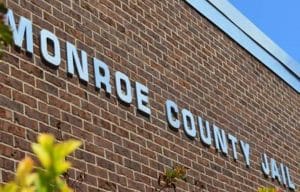Ridin’ the storms out
Severe Weather Preparedness Month may have just ended, but lessons on how and when to alert the public about Mother Nature’s wrath continue to be learned through each passing storm.
Such was the case early Tuesday morning.
“We dodged a bullet,” Monroe County Public Safety Director Kevin Scheibe said late Tuesday morning.
As a severe thunderstorm rolled through the St. Louis area about 1:30 a.m., Monroe County Emergency Management Agency officials were wide awake and watching the skies.
Reports of a possible tornado observed in the area of Bonne Terre, Mo., resulted in the EMA sending out an informational page for Maeystown firefighters to be on alert and Code Red emergency phone and text notifications sent to many residents.
Shortly before 1:45 a.m., a Monroe County Sheriff’s Department deputy reported what appeared to be a rotational cloud in the area of H Road just east of Waterloo, resulting in a similar informational page to Waterloo firefighters.
Fortunately, all Monroe County received from this latest storm were bouts of rain and a bit of hail.
Such was the case – albeit with reports of much larger hail – during an early evening storm that pelted this area March 14.
However, the National Weather Service said an area of reported wind damage and potential tornadoes that stretches from Park Hills, Mo., east through the bottom half of neighboring Randolph County was being assessed Tuesday and Wednesday.
Complicating matters for emergency officials early Tuesday morning, per Scheibe, was the fact the St. Louis office of the weather service was having information technology issues.
“The NWS radar system being down really tested things,” Scheibe said. “The NWS could only communicate with us via chat and satellite pics from Paducah and Kansas City, which was delaying like 20-plus minutes. Then they couldn’t update warning boxes. All worked out, though.”
Hoping to alleviate concerns local residents expressed following the early morning scare, the Monroe County EMA took to Facebook to provide some insight.
A couple of these concerns dealt with the sounding of tornado sirens during this latest storm.
First was the complaint that some sirens sounded in areas that were not in the designated tornado warning zone.
The EMA explained that this was mostly due to the NWS radar issues.
“We have direct communications with the NWS and were advised of some possible rotation near Waterloo and to the north and east,” Scheibe said. “This is why the sirens were set off in those areas without them being within the tornado warning area. A county deputy also communicated to 911 via radio that he was observing cloud rotation while patrolling. The observation of rotation was not in the current posted warning zone.”
Another complaint by some regarding tornado sirens was that they were either too quiet or did not wake them up in the middle of the night when the storm rolled through.
The EMA stressed that tornado sirens are mostly intended to warn residents when they are outside, not when they are inside their homes.
“If you want something to warn you in your house or wake you up, then you need to purchase a weather radio which can be set up to go off when a warning is issued for your county,” Scheibe said.
Another concern addressed by the EMA dealt with phone notifications, mainly the difference between some receiving them while others did not.
“First and easiest to explain is the Emergency Alert System has been turned off on their phone,” Scheibe said. “This can be checked in the settings of your phone. Second is that it depends on which tower your phone is connected to. If it was connected to a tower within the warned area, then it will go off. If the tower was not within the warned area, then it will not. Your phone is set to switch towers as you move. Once the signal goes below the preset limits, it moves to the strongest signal and associates with that tower.”
A scenario used to explain this, as shared by the EMA, had a husband and wife traveling together by car from Columbia to Waterloo, with the woman’s phone in a purse on the floorboard and the husband’s phone in the center console.
“The (wife’s) phone, being in a purse on the floorboard, will have a weaker signal to change to the Waterloo tower before his will,” Scheibe said. “Now a tornado warning goes off which covers Waterloo but not Columbia, (the wife’s) phone will go off because the Waterloo tower is within the warned area and sends out the EAS message but the husband’s phone would not go off because the Columbia tower, which his phone is associated with, is not within the warned area so it did not send out the message.”
Scheibe further explained that your phone will not look for a different tower to communicate with until its signal gets below the preset limits set by the carrier.
“Yes, you can be standing next to each other and still be associated with different towers,” he said.
Local residents not already signed up for Code Red notifications are encouraged to do by visiting monroecountyil.gov/departments/emergency-management-agency.
March was Severe Weather Preparedness Month, and the Illinois Emergency Management Agency stressed that “everyone in Illinois should be prepared for adverse conditions.”
Per the IEMA, Illinois averages 53 tornadoes per year and ranks fourth in the United States for most tornadoes per square mile.
For IEMA’s severe weather tips, visit iemaohs.illinois.gov.






